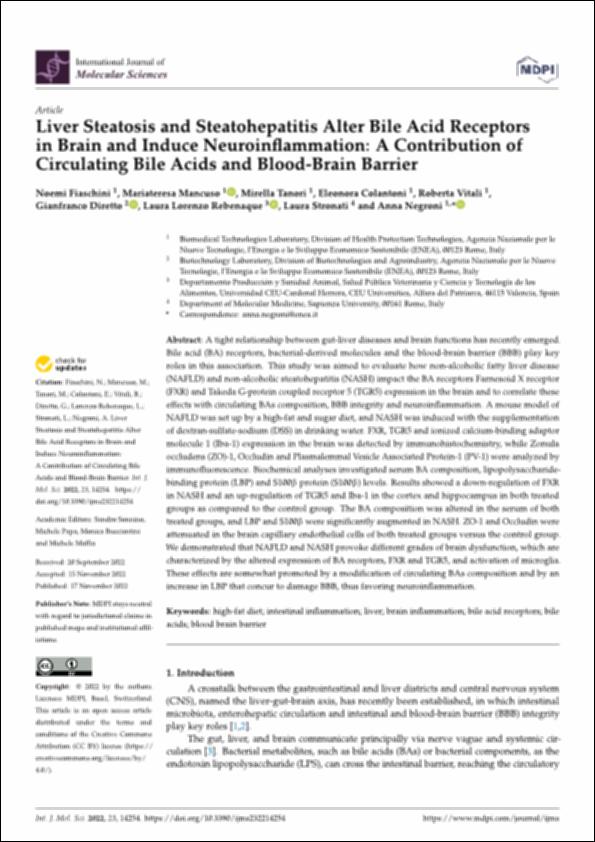Please use this identifier to cite or link to this item:
http://hdl.handle.net/10637/14413Liver steatosis and steatohepatitis alter bile acid receptors in brain and induce neuroinflammation a contribution of circulating bile acids and blood-brain barrier
| Title: | Liver steatosis and steatohepatitis alter bile acid receptors in brain and induce neuroinflammation a contribution of circulating bile acids and blood-brain barrier |
| Authors : | Fiaschini, Noemi Mancuso, Mariateresa Anori, Mirella Colantoni, Eleonora Vitali, Roberta Diretto, Gianfranco Lorenzo Rebenaque, Laura |
| Keywords: | Ácidos biliares - Receptores.; Bile acids - Receptors.; Intestinos - Inflamación.; Hígado.; Encefalitis.; Encephalitis.; Intestines - Inflammation.; Liver. |
| Publisher: | MDPI |
| Citation: | Fiaschini, N., Mancuso, M., Tanori, M., Colantoni, E., Vitali, R., Diretto, G., Lorenzo Rebenaque, L., Stronati, L. & Negroni, A. (2022). Liver steatosis and steatohepatitis alter bile acid receptors in brain and induce neuroinflammation: a contribution of circulating bile acids and blood-brain barrier. International Journal of Molecular Sciences, vol. 23, i. 22 (17 nov.), art. 14254. DOI: https://doi.org/10.3390/ijms232214254 |
| Abstract: | A tight relationship between gut-liver diseases and brain functions has recently emerged. Bile acid (BA) receptors, bacterial-derived molecules and the blood-brain barrier (BBB) play key roles in this association. This study was aimed to evaluate how non-alcoholic fatty liver disease (NAFLD) and non-alcoholic steatohepatitis (NASH) impact the BA receptors Farnesoid X receptor (FXR) and Takeda G-protein coupled receptor 5 (TGR5) expression in the brain and to correlate these effects with circulating BAs composition, BBB integrity and neuroinflammation. A mouse model of NAFLD was set up by a high-fat and sugar diet, and NASH was induced with the supplementation of dextran-sulfate-sodium (DSS) in drinking water. FXR, TGR5 and ionized calcium-binding adaptor molecule 1 (Iba-1) expression in the brain was detected by immunohistochemistry, while Zonula occludens (ZO)-1, Occludin and Plasmalemmal Vesicle Associated Protein-1 (PV-1) were analyzed by immunofluorescence. Biochemical analyses investigated serum BA composition, lipopolysaccharidebinding protein (LBP) and S100 protein (S100 ) levels. Results showed a down-regulation of FXR in NASH and an up-regulation of TGR5 and Iba-1 in the cortex and hippocampus in both treated groups as compared to the control group. The BA composition was altered in the serum of both treated groups, and LBP and S100 were significantly augmented in NASH. ZO-1 and Occludin were attenuated in the brain capillary endothelial cells of both treated groups versus the control group. We demonstrated that NAFLD and NASH provoke different grades of brain dysfunction, which are characterized by the altered expression of BA receptors, FXR and TGR5, and activation of microglia. These effects are somewhat promoted by a modification of circulating BAs composition and by an increase in LBP that concur to damage BBB, thus favoring neuroinflammation. |
| Description: | Este artículo se encuentra disponible en la siguiente URL: https://www.mdpi.com/1422-0067/23/22/14254 En este artículo de investigación también participan: Laura Stronati y Anna Negroni. Este artículo de investigación pertenece al número especial "State-of-the-Art Molecular Neurobiology in Italy". |
| URI: | http://hdl.handle.net/10637/14413 |
| Rights : | http://creativecommons.org/licenses/by/4.0/deed.es |
| ISSN: | 1422-0067 (Electrónico) |
| Language: | es |
| Issue Date: | 17-Nov-2022 |
| Center : | Universidad Cardenal Herrera-CEU |
| Appears in Collections: | Dpto. Producción y Sanidad Animal, Salud Pública Veterinaria y Ciencia y Tecnología de los Alimentos |
Items in DSpace are protected by copyright, with all rights reserved, unless otherwise indicated.


